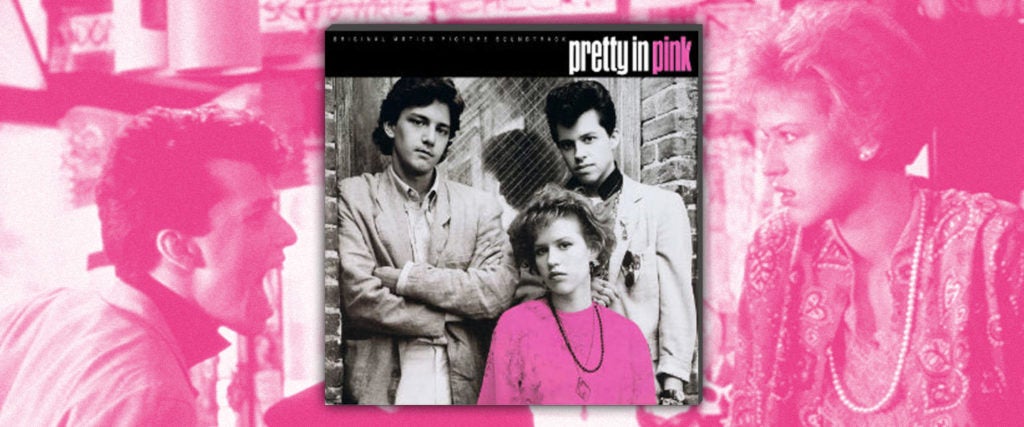On February 28, 1986 — 35 years ago — the high school romantic comedy Pretty in Pink opened wide in theaters across the U.S. Though it was directed by Howard Deutch, the movie’s biggest behind-the-camera name was its screenwriter and co-executive producer, John Hughes, whose previous films Sixteen Candles and The Breakfast Club had established him as a writer unusually adept at creating characters and telling stories that resonated with 1980s teenagers. Hughes’ movies were fast-paced, erudite and funny. They took adolescent angst seriously, but were also filled with joy and creativity… and, of course, with great music.
The 35th anniversary of Pretty in Pink is also the 35th anniversary of the Pretty in Pink soundtrack, a cultural artifact arguably more significant than the motion picture. The record was packed with songs by musicians who at the time were relatively popular in the U.K. but known mainly in the U.S. to fans of college radio. The Psychedelic Furs, New Order, the Smiths, Echo & the Bunnymen and Orchestral Manoeuvres in the Dark were some of the most beloved acts of the 1980s — especially to teenagers who liked their rock ’n’ roll to be a little dreamy and very moody.
I was a 15-year-old Nashville suburbanite when Pretty in Pink debuted, and I was a devoted fan of the Vanderbilt University station. I still remember how disorienting it was to hear songs from the soundtrack wafting out of car windows in my high school parking lot. Suddenly, even the jocks were digging the Smiths. It was wild, and (to paraphrase another John Hughes/Howard Deutch movie) kind of wonderful.
The Pretty in Pink soundtrack was also a departure of sorts from earlier high school movies. Consider 1982’s Fast Times at Ridgemont High, which to a large extent reflected the sensibility of its screenwriter, Cameron Crowe. That film and its music captured Crowe’s keen understanding of mainstream American adolescence in the early 1980s: a time of sex, drugs and machine-tooled corporate rock. The Fast Times soundtrack featured Billy Squier, Sammy Hagar, Quarterflash, Joe Walsh, Stevie Nicks, The Go-Go’s, Don Henley… hitmakers, all.
Though Hughes was seven years older than Crowe, he was, in his own way, hipper. Hughes’ writing talent had been nurtured first in the advertising industry and then via his work with National Lampoon magazine, both of which encouraged a sort of self-aware flippancy.
Yet the major keys to Hughes’ success in Hollywood were his sentimentality and his innate understanding of his audience’s deepest fantasies. In Fast Times and in his directorial debut Say Anything…, Crowe reported on teenagers as he saw them: as sincere creatures trying to satisfy their simple needs for companionship and hedonistic pleasure. Hughes, on the other hand, depicted teens as they saw themselves: complicated and poetic, with cool exteriors and rich interior lives.
You can hear a little of that romantic mythologizing of adolescence in the soundtracks to Hughes’ first two movies as a writer-director. In Sixteen Candles, when the central couple finally gets together, the moment is scored by Thompson Twins’ bittersweet ballad “If You Were Here,” a song that pre-dates the band’s American hits. The Breakfast Club begins with a David Bowie quote and ends with “Don’t You (Forget About Me),” the song that ended up being Simple Minds’ breakthrough on the U.S. charts. Hughes created a world on-screen where Thompson Twins and Simple Minds were the bands who really spoke to a wide swath of America’s kids, and whose songs played in the background of their biggest moments. It was a world that, frankly, didn’t really exist until Hughes concocted it.
With Pretty in Pink, Hughes took an even bigger swing. He had his “Don’t You”/“If You Were Here” moment with O.M.D.’s “If You Leave,” a booming love song that became that band’s biggest U.S. hit. Echo & the Bunnymen wrote and recorded one of their catchiest and prettiest songs, “Bring on the Dancing Horses,” specifically for the movie (though the band jumped the gun and made it the closing track on their 1985 hits collection Songs to Learn & Sing). The Smiths’ “Please, Please, Please Let Me Get What I Want” was a U.K. single that hadn’t been officially released stateside at the time. It closed out the album, capturing the youthful yearning of Molly Ringwald’s heroine.
Let me be clear: The bands above were hardly obscure in 1986. Even if they weren’t being played on American Top 40, they’d already made some of the burgeoning alternative music scene’s best-loved records. Still, post-Pretty in Pink, the Smiths, the Bunnymen, the Furs and New Order all made a level-jump in their name-recognition and album sales in the U.S. And a few of their fellow travelers on the British post-punk and New Wave scenes — like the Cure and Depeche Mode — became bona fide stars on American radio and MTV.
Hughes wasn’t solely responsible for this. That said, it’s worth noting that in 1986, the music in Pretty in Pink signified that the filmmaker was positioning his heroine as someone cool and different — today, these bands just represent “the 1980s.” Generally speaking, most people who were moviegoing (or VHS-renting) teens in the late 1980s know these songs well.
As for what’s not on the Pretty in Pink soundtrack… Well, that’s interesting too, in that the missing songs point to some of the paths Hughes would follow in the ensuing decades. For example, a nightclub scene in the movie features the jangly Americana act the Rave-Ups and their fantastic anthem “Positively Lost Me,” and in one of the film’s most memorable moments, Jon Cryer’s character Duckie lip-syncs along to Otis Redding’s “Try a Little Tenderness.” Neither of these made it onto the album, and honestly, they wouldn’t have fit the overall vibe. But they are more in line with the kind of music Hughes would pick for his 1990s films.
Most of the rest of Hughes’ 1980s scores were just as heavy on British bands as Pretty in Pink. The Hughes-directed Ferris Bueller’s Day Off also hit theaters in 1986, featuring poppy songs by the likes of General Public, Big Audio Dynamite and the Dream Academy. In 1987’s Pretty in Pink-like Some Kind of Wonderful, Hughes went with heavier, dreamier U.K. acts like the Jesus and Mary Chain, Flesh for Lulu and the March Violets. The mature 1988 domestic comedy She’s Having a Baby had Everything but the Girl, XTC, Kirsty MacColl and — backing the movie’s emotional childbirth scene — the Kate Bush ballad “This Woman’s Work.”
But around the same time as She’s Having a Baby, Hughes also wrote and directed the cross-country comedy Planes, Trains and Automobiles, which was about two middle aged men and thus featured more vintage pop, country and R&B on the soundtrack. That’s the mode Hughes stayed in for much of the next decade. He made a few more movies with his Planes star John Candy; and after he wrote the smash hit Home Alone (directed by Chris Columbus), Hughes moved hard into family films, writing the likes of Beethoven, Baby’s Day Out and Flubber. In nearly every case, the music choices stayed stubbornly in the middle of the road, relying primarily on familiar old songs, often from decades ago.
The major exception from Hughes’ later work — before he went into semi-retirement in the 2000s, then died in 2009 — was the soundtrack for the obscure 1997 film Reach the Rock. His son John Hughes III released the record on his own independent label, and collected tracks from Chicago’s happening “post-rock” scene, spotlighting jazzy and droning experimental songs by bands like Tortoise and the Sea and Cake. Suddenly, Hughes was cool again… or he would’ve been, if anyone had seen the picture.
Hughes’ classic 1980s comedies remain hugely influential, having inspired many youth-oriented filmmakers that followed to make their protagonists quirky and witty — and, for a time, to fill their movies’ soundtracks with cutting-edge pop and rock. The musical styles are very different, but the scores to 1990s teen faves like Can’t Hardly Wait, She’s All That, Clueless, 10 Things I Hate About You and Romeo + Juliet each try to capture — and in some ways to shape — the sounds of their era.
This is an art I fear is getting lost. Lately, many of the high school romances — especially the ones popular on Netflix — seem to focus on kids who love 1980s music, and who rarely shuffle up a song recorded in the past five years. It’s almost as though the filmmakers’ musical tastes were shaped by watching John Hughes movies. That’s fine, for adult viewers looking for a nostalgic jolt. It’s a shame, though, that more teen movie soundtracks aren’t like Pretty in Pink, at once winking to the hepcats and guiding the tastes of their peers.
Even if it was something he did unconsciously, Hughes understood something important about the intersection between musical taste and teen identity. Just give a listen to Pretty in Pink’s title track: a Psychedelic Furs song originally released on the band’s rowdy 1981 masterpiece Talk Talk Talk. The Furs re-recorded the song for the film, ditching the aggressive guitar noise and softening Richard Butler’s sandpaper vocals. The edge is still there, but the softness that had always been just beneath its jagged surface is now easier to hear. The new version is like a John Hughes production in miniature — a spunky misfit that unexpectedly has broad appeal.

